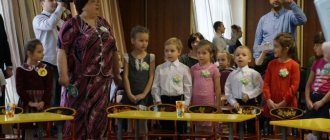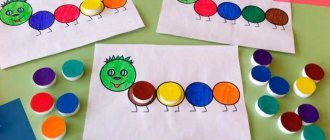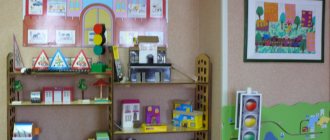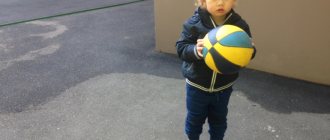Features of the assimilation of literary text by preschool children
Works of literature contribute to the development of the language and provide examples of the Russian literary language. With the help of the literary word, even before school, even before learning grammatical rules, the child practically learns the grammatical norms of the language in unity with vocabulary. The child learns many new words and figurative expressions from the book, his language is enriched with emotional vocabulary.
A work of art is valuable because it directly affects the child. By creating it, the author, of course, provides the opportunity for the child to independently study the content, achieving emotionality and clarity of the story, where morality naturally follows from the actions and deeds of the characters. Therefore, the goal of many methodological techniques is to facilitate the process of listening and understanding (to help remember the work, to feel it more deeply).
In the introduction to the literary text, a clear connection is made between the development of language and the aesthetic; language is studied in its aesthetic function. Knowledge of the means of linguistic expression serves to develop the artistic perception of literary works.
The tasks and content of introducing children to literature in a preschool setting are determined on the basis of knowledge of the characteristics of perception and understanding of works of literature and are presented in kindergarten programs.
In general terms, these tasks were formulated by methodologists S.I. Karpova and V.V. Mamaev as follows:
- To instill an interest in fiction, develop the ability to holistically perceive works of different genres, ensure the assimilation of the content of the work and an emotional reaction to it;
- form first ideas about the features of fiction
- contribute to the development of literary and artistic taste, the ability to understand and feel the mood of a work, to capture the musicality, sonority, rhythm, beauty and poetry of works, to develop a poetic ear.
Children also develop the ability to elementary analyze the content and form of a work.
The perception of fiction is considered as an active volitional process, including passive contemplation and activity, embodied in internal assistance, empathy for characters, imaginary transfer of events to oneself, “mental action”, the effect of personal presence, personal participation in events is created.
O.S. Ushakova and O.I. Nikiforov distinguishes three stages in the development of perception of a work of art: “direct perception, reconstruction and experience of images (based on the work of the imagination); understanding the ideological content of the work (based on thinking); the impact of fiction on the teacher’s personality (through feelings and consciousness).”
A child's perception of art in preschool age develops and improves. L.M. Gurovich, based on a generalization of scientific data and his own research, examines the age-related characteristics of preschoolers’ perception of literary works and identifies “two periods in their aesthetic development: from 2-5 years, when the child does not yet clearly separate life from art, and after five years “when art, including language arts, becomes valuable in itself for a child.”
Dramatization for children of the senior group “A Very Scary Fairy Tale”
Elena Lebedeva
Dramatization for children of the senior group “A Very Scary Fairy Tale”
Characters: storyteller , bear, fox, hare, hedgehog, wise owl, mouse, girl Sparkle, squirrel, woodpecker. girls. girl and boy.
Storyteller . Hello, dear friends, I am very glad to see you today. We will show you a very scary fairy tale . Why have you all become so sad? Don't worry, our fairy tale ends well. In it, friendship and love are stronger than evil. Watch and listen carefully. The fairy tale begins .
Forest, birch, fir trees, mushrooms, flowers appear to the music (together.)
We are flower girls, green leaves.
We play with the breeze, we nod our heads! They dance (run away.)
The fox and the bear enter.
Fox - Oh, how boring it is to live in the forest.
Wolf - That's right, little fox. And I'm bored!
Lisa - What should I do?
Wolf - Maybe we can play catch up?
Fox - Reluctant, tired of everything (takes out a matchbox)
One day I was walking along the path and found a box of matches.
Wolf - It would be better to have a juicy pork or goat cutlet.
Fox - Come on, gray one, let's play with matches, set the bushes and grass on fire.
It's so interesting.
Wolf - come on! The wolf and the fox light matches and throw them on the grass.
A wise owl flies in.
Owl - Who is disturbing the order in the forest? Who's playing with matches here? Who's setting the grass on fire here? Have you forgotten that you can’t play with fire? Summer is dry. The forest can burn, then all the birds and animals will leave it.
Fox - Nothing will happen to your forest, fly, fly, out of here! A girl, Sparkle, appears in her hands, holding blue ribbons. blue, pink. orange, red and yellow, dancing.
Fox - Oh, what a beautiful fire! Here it is red, here it is blue.
Wolf - But where did the smoke come from?
Owl - Fire! Fire! We're on fire! We're on fire!
Wolf - I’m suffocating, the cough is suffocating! The acrid smoke is drying out my throat! Oh! Oh! Save the little fox. Bring me some water!
Lisa - How can I help you? Well, quickly run away! (the fox and the wolf run away.)
Owl - Fire! We're on fire! Birds, animals, run away and save your children (Flies away.)
“Tongues of flame” with red ribbons run out and dance.
Morning. A hedgehog with a basket in his hand approaches the hare's house and knocks on the door.
Hedgehog - Come on, hare. wake up, get ready to pick mushrooms, we’ll run along the path and pick a basket of mushrooms. A hare comes out of the house with a basket in his hand.
Hare - What, are you a hedgehog screaming? I got ready a long time ago (closes the door.)
You see, he closed his house and didn’t forget his basket?
The hare and the hedgehog go for mushrooms and sing a song. A mouse comes towards them.
Mouse - Hello, little animals!
Hare and hedgehog - Hello, little mouse! You. Where are you going?
Mouse - For mushrooms.
Hare. Go with us. It’s more fun together (the animals sing a song and leave.)
A wise owl walks through a burnt forest. A mouse, a hedgehog, and a hare appear.
Mouse - Where are we?
Hedgehog - Why is this forest so dark?
Owl - What don’t you see? You have come to a dead forest. He burned. Nobody lives here.
Mouse - So we won’t find mushrooms here?
Owl - Nothing grows here anymore.
Hare - How scary .
Hedgehog - Even the bird doesn’t sing here, the grass doesn’t grow here, the daisies don’t sway, the sun doesn’t smile, the grasshopper doesn’t chirp here, no one wants to walk here.
Hare - Only the black branches are swaying, scratching and creaking, as if they want to scare us!
Mouse - How scary !
hare - I wouldn’t want to live in this forest.
Yozh-I, I wouldn’t want to!
Owl - We need to save the forest!
M-Oh, how?
Owl - I think all the animals should be called, and the burnt trees should be removed!
Hare - Correct! Let's remove the burnt trees and plant our own forest!
Together! Hey animals! Come here! Help us work! To the music of an owl, a hare, a hedgehog, a mouse. a bear, a woodpecker, and a girl are cleaning up the forest. from burnt trees. "Seedlings" are planted.
Mouse - How tired I am.
Hare - And I'm tired. There was enough work for everyone.
Bear - They did a great job, at least the seedlings took root.
Woodpecker - The forest will take a long time to grow, it’s not easy to save it! It’s not without reason that the rumor says: “Take care of the forest from fire.”
Squirrel-Nothing, the warm rain will pour it down, so our forest will grow. The pines will rustle here, the birds will sing songs!
Hare - And the cheerful animals will begin to collect honey mushrooms, they will come to the forest with baskets, and pick wild berries.
Bear-I, remember the animals! The forest must be protected, because it is our home, it is our wealth!
Woodpecker - Many herbs, trees, flowers, berries and mushrooms grow in the forest, which benefit us.
Hedgehog - Don’t litter in the forest! Don’t set the grass on fire!
Squirrel - Don’t pick flowers in vain! And don’t break trees! Don't destroy anthills! Don't destroy birds' nests!
Together; Take care of the forest! the animals sing a song about the forest! They bow to the audience and leave. ,
Using drama games in elementary school lessons
Game functions are different:
1.Facilitate the learning process and revive it
. This role is played by fairy-tale elements, entertaining pictures, and fairy-tale characters.
2."Theatricalization"
educational process: game forms introduce a role-playing element, for example fictional characters. Artistic techniques are used in role-playing dialogues, in staging fables, fairy tales, in compiling various exercises, tasks by the students themselves, and even in compiling pages of the proposed textbook.
3.Competitive.
The game introduces an element of competition, competition, stimulates activity and the desire for leadership. From the simplest cases, the game moves on to olympiads, to testing, to literary creativity, to competition in the quality and depth of knowledge.
The named three functions of the game represent steps from the game - fun to the game - passion for knowledge. This is the highest level - from play to creativity, to scientific logic to ahead of school programs.
Since ancient times, educators have been looking for ways to best teach children. The task is to determine such methods and technologies so that it proceeds quickly and efficiently, with a reasonable expenditure of effort from teachers and students. A lot has already been tried. There is not a single more or less obvious path left that teachers have not tried to follow. All the most valuable things have settled in the arsenal of scientific didactics, the practical task of which is to show teachers the most rational ways to quickly acquire knowledge, skills, and abilities developed by previous generations of teachers. Children do not set any goals in the game other than the goal of playing. But it would be wrong not to take into account the educational and developmental influence of the game while maintaining the spontaneity of children’s lives in it. Play is a means of education when it is included in a holistic pedagogical process. The value of play as an educational tool lies in the fact that, by influencing the group of children playing, the teacher, through the team, influences each of the children. By organizing the lives of children in the game, the teacher forms not only game relationships, but also real ones, consolidating useful habits into the norms of behavior of children in different conditions and outside the game - thus, with the correct guidance of children, the game becomes a school of education.
The didactic game as an independent gaming activity is based on the awareness of this process. Independent play activity is carried out only if children show interest in the game, its rules and actions, if these rules have been learned by them. How long can a child be interested in a game if its rules and content are well known to him? Children love games that are familiar to them and enjoy playing them. This can be confirmed by the rules of folk games that children know: “ Colors”, “We won’t tell you where we were, but we’ll show you what we did”, “On the contrary”
and others.
Each such game contains interest in game actions. For example, in the game “Paints”
you need to choose a color. Children usually choose their favorite and fabulous colors: gold, silver. Having chosen a color, the child approaches the driver and whispers the name of the paint in his ear. “Jump along the path on one leg,” says the driver to the one who named the paint, which is not among the players. There are so many interesting play activities for children here! That's why children always play such games. The problem of the learning process is that the children play independently, so that they always have such games in stock, so that they themselves can organize them as they develop, and be not only participants and fans, but also fair judges. Moving further in the learning process, it is absolutely necessary to complicate the games, supplementing them with an increasing number of rules that would contain not only a technical focus, but would add a new color of aesthetics, reveal figurative concepts of morality, and in the complex would not allow the childish interest in the game to fade away.







